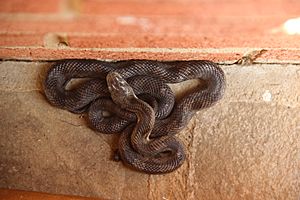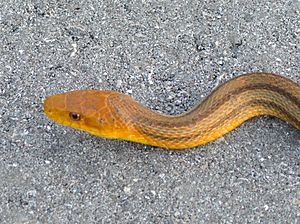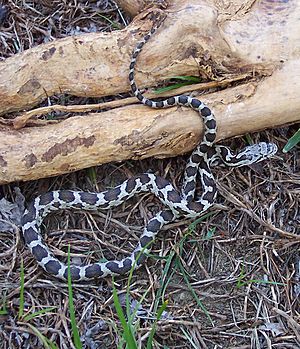Eastern ratsnake facts for kids
Quick facts for kids Eastern ratsnake |
|
|---|---|
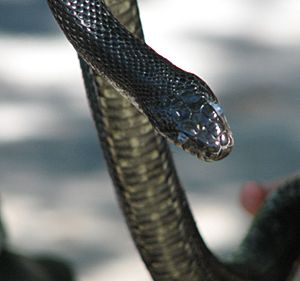 |
|
| Adult eastern ratsnake Murphys Point Provincial Park, Ontario |
|
| Conservation status | |
| Scientific classification | |
| Genus: |
Pantherophis
|
| Species: |
alleghaniensis
|
| Synonyms | |
|
|
The eastern ratsnake (scientific name: Pantherophis alleghaniensis) is a type of snake that is not venomous. It lives only in North America. This snake is part of the colubrid family.
Contents
What are other names for the Eastern Ratsnake?
The eastern ratsnake has many other names. Some people call it the black rat snake or pilot snake. It is also known as the pilot black snake or chicken snake. In Florida, it might be called the yellow rat snake or Everglades rat snake.
Where do Eastern Ratsnakes live?
You can find Pantherophis alleghaniensis in the United States. They live east of the Apalachicola River in Florida. They are also found east of the Chattahoochee River in Georgia.
These snakes live east of the Appalachian Mountains. Their range goes north to southeastern New York and western Vermont. You can also find them in eastern Pennsylvania, Maryland, South Carolina, and North Carolina. They live south to the Florida Keys. In the Florida Panhandle, they sometimes breed with the gray rat snake.
What do Eastern Ratsnakes look like?
Adult eastern ratsnakes are usually 3 to 6 feet (91 to 183 cm) long. Some can grow even longer than 6.5 feet (200 cm). The longest one ever recorded was 7.5 feet (229 cm) long.
Adult snakes have shiny black backs. Their chin and throat are cream or white. Their belly has a black and white checkerboard pattern. This pattern becomes a solid gray color near the tail.
Young snakes look different. They have dark blotches on a grayish background. Their belly pattern is like the adults. Their eyes are round with a black center. They often have a clear white ring around their eyes.
The scales on their back are slightly ridged. These scales are arranged in 23 to 27 rows around the middle of their body. Both male and female snakes have the same colors. Males have slightly longer tails than females.
Where do Eastern Ratsnakes like to live?
Eastern ratsnakes live in many different places. They can be found on farms and in hardwood forests. They also live in wet forests and thick bushes. You might see them in fields next to forests. They can even live in small wooded areas in cities and in backyards.
These snakes do very well in areas where habitats meet, like where a forest meets a field. They are good climbers. This means they can sometimes get into people's homes. They might live in attics without anyone knowing. In colder areas, they need good places to hide for winter. They prefer sunny spots to stay warm in spring and fall.
How do Eastern Ratsnakes behave?
Eastern ratsnakes are active at night during summer. In spring and fall, they are active during the day. They can burrow into the ground and are excellent climbers. They can also go into water. You might find them under rocks, boards, or in trees. They hide under bark or in tree holes.
What do Eastern Ratsnakes eat?
These snakes are constrictors. This means they squeeze their prey to eat it. Adult snakes mainly eat warm-blooded animals. Young snakes mostly eat cold-blooded animals. Their diet includes small animals like rodents, lizards, and frogs. They also eat birds and their eggs. Sometimes, they eat young chickens, which is why they are called "chicken snakes."
Who are their predators?
Young ratsnakes are most at risk from predators. Animals that hunt them include hawks and great horned owls. Foxes, raccoons, and house cats also hunt them. Adult eastern ratsnakes have few predators other than humans.
When scared, a ratsnake will freeze. If bothered, it will release a bad-smelling liquid to scare away predators. If it feels very threatened, it might coil up. It may also shake its tail and try to bite.
How do Eastern Ratsnakes reproduce?
These snakes sleep during the winter. They hide underground or in deep cracks. They might share their winter dens with other snakes. These can include copperheads and timber rattlesnakes. In northern areas, they are active from late April to October. They usually mate in May or June. In the South, they are active earlier.
Ratsnakes become old enough to have babies when they are about four years old. They start breeding in May and June. Males will approach females to begin mating. They might fight other males before mating. About five weeks after mating, the female lays her eggs. She lays 5 to 27 eggs. She hides them in hollow trees, compost piles, or rotting logs. The eggs hatch after about two months. This happens from July through September. Baby snakes are usually just over a foot (30 cm) long when they hatch. They have the gray and black pattern that young snakes are known for.
How are Eastern Ratsnakes classified?
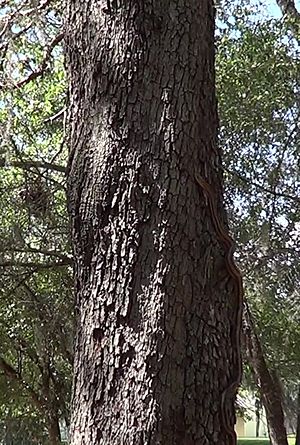
The eastern ratsnake, Pantherophis alleghaniensis, was once thought to be a type of Pantherophis obsoletus. They are very closely related. This species was often placed in the group called Elaphe. However, recent studies have shown it belongs in the group Pantherophis.
- Pantherophis alleghaniensis at the TIGR Reptile Database. Accessed 29 November 2008.



